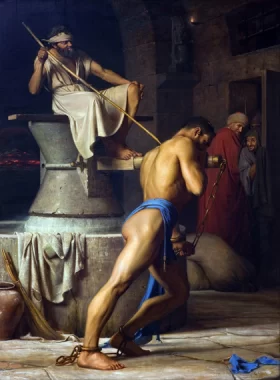5% rabatt bruk koden KMNO5 ved kassen
- Choose your Country
5% rabatt bruk koden KMNO5 ved kassen
Realism
Realism in the visual arts is a style that depicts the actuality of what the eyes can see. The term is used in different senses in art history, it may mean the same as illusionism, the representation of subjects with visual mimesis or verisimilitude, or may mean an emphasis on the actuality of subjects, depicting them without idealization, and not omitting their sordid aspects. Works may be realist in either of these senses, or both. Use of the two senses can be confusing, but depending on context the second sense is perhaps more common.
Realism as a tendency in 19th century art was related to similar movements in the theatre, literature and opera. All emphasized the depiction of everyday subjects, but by no means always discarding classical, Romantic or sentimental approaches to their treatment. The movement began in the 1850s in France. One of Gustave Courbet’s most important works is A Burial at Ornans, 1849-1850, a canvas recording an event which he witnessed in September 1848. Courbet’s painting of the funeral of his grand uncle became the first grand statement of the Realist style.
Realism in the illusionistic sense appears in art as early as 2400 BC in the city of Lothal in what is now India, and examples can be found throughout the history of art – Ancient Egyptian art had rigid and artificial conventions for the depiction of the human figure, but minor figures and animals are often very well-observed, and lifelike. In the broadest sense, realism in a work of art exists wherever something has been well observed and accurately depicted, even if the work as a whole does not strictly conform to the conditions of realism.
The art of ancient Greece made particular progress in developing realistic depictions of both the human figure and its surroundings, in sculpture and painting. In the Late Antique period realism largely ceased to be a priority for artists, and the recovery of the realist tradition is a constant strand in the history of Western medieval art.
For example, the proto-Renaissance painter Giotto di Bondone brought a new realism to the art of painting by rendering physical space and volume far more convincingly than his Gothic predecessors. His paintings, like theirs, represented biblical scenes and the lives of the saints. In the Early Renaissance, the development of a system of linear perspective in Italy, and the inclusion of naturalistic detail in Early Netherlandish painting both contributed to the advance of realism in Western painting in different ways.
In the late 16th century, the prevailing mode in European art was Mannerism, an artificial art of elongated figures in graceful but unlikely poses. Caravaggio emerged to change the direction of art by depicting religious figures as the Italian poor in their natural surroundings, though composed with Baroque energy.
A fondness for humble subjects and homely details characterizes much of Dutch art, and Rembrandt is an outstanding realist in the naturalist sense with his renunciation of the ideal and his embrace of the life around him. In the 19th century a group of French landscape artists known as the Barbizon School emphasized close observation of nature, paving the way for the Impressionists.
In England the Pre-Raphaelite Brotherhood rejected what they saw as the formulaic idealism of the followers of Raphael, which led some of them to an art of intense illusionistic, and sometimes naturalistic, realism. The final years and aftermath of the First World War saw a return of realism and of styles dating back to before Post-Impressionism, in the so-called «Return to Order» – this became known as «Neo-Realism» or «Modern Realism» in England (led by Meredith Frampton, Charles Ginner, Harold Gilman and the Euston Road School), traditionisme in France (led by Andre Derain) and «Neue Sachlichkeit» (led by Otto Dix and Christian Schad) and «Magic Realism» in Germany.
Trompe l’oeil (literally, «fool the eye»), a technique which creates the illusion that the objects depicted actually exist, is an extreme example of artistic realism. Examples of this tendency can be found in art from antiquity to the present day
Read moreViser 1–100 av 2193 resultater

A Burial at Ornans
By Gustave CourbetSizes starting at kr4.709
A stream through the valley, deer in the distance 1905
By Peder Mørk MønstedSizes starting at kr3.079
Breezing Up (A Fair Wind)
By Winslow HomerSizes starting at kr3.719
Chop Suey
By Edward HopperSizes starting at kr2.629
Danseuse Au Repos 1879
By Edgar DegasSizes starting at kr2.779
Gleaners 1857
By Francois MilletSizes starting at kr3.349
In A Roman Osteria
By Carl Heinrich BlochSizes starting at kr3.459
The Heart’s Awakening 1982
By William-Adolphe BouguereauSizes starting at kr3.559
A tranquil forest lake 1904
By Peder Mørk MønstedSizes starting at kr2.969
East Wind Over Weehawken 1934
By Edward HopperSizes starting at kr3.339
Samson And The Philistines
By Carl Heinrich BlochSizes starting at kr3.349
Snap the Whip 1872
By Winslow HomerSizes starting at kr4.139
Songs of Spring 1889
By William-Adolphe BouguereauSizes starting at kr3.599
The Angelus
By Francois MilletSizes starting at kr3.239
The Bathers 1853
By Gustave CourbetSizes starting at kr2.699
Trois Danseuses
By Edgar DegasSizes starting at kr2.939
A summer day in the forest with deer in the background 1908
By Peder Mørk MønstedSizes starting at kr2.999
Ballet, 1876
By Edgar DegasSizes starting at kr3.179
Christ The Consolator
By Carl Heinrich BlochSizes starting at kr3.589
Cliffs of Gréville
By Francois MilletSizes starting at kr2.719
Dream of Spring 1901
By William-Adolphe BouguereauSizes starting at kr3.779
Hotel-Window
By Edward HopperSizes starting at kr2.829
The Meeting Or «Bonjour, Monsieur Courbet» 1854
By Gustave CourbetSizes starting at kr3.109
The Veteran in a New Field 1865
By Winslow HomerSizes starting at kr3.159
Brook Flowing Through a Spring Wood, 1918
By Peder Mørk MønstedSizes starting at kr3.159
Christ And Child
By Carl Heinrich BlochSizes starting at kr3.879
Hunting Birds at Night
By Francois MilletSizes starting at kr2.819
Nighthawks 1942
By Edward HopperSizes starting at kr3.279
The artist’s Studio
By Gustave CourbetSizes starting at kr4.179
The Assault 1898
By William-Adolphe BouguereauSizes starting at kr3.819
The Gulf Stream 1899
By Winslow HomerSizes starting at kr3.249
The Star
By Edgar DegasSizes starting at kr3.049
A Woman in the Sun
By Edward HopperSizes starting at kr2.939
Man with a Hoe
By Francois MilletSizes starting at kr2.989
Right and Left 1909
By Winslow HomerSizes starting at kr3.169
River through the Woods 1905
By Peder Mørk MønstedSizes starting at kr3.249
The Ballet Class 1874
By Edgar DegasSizes starting at kr3.179
The Invasion 1892
By William-Adolphe BouguereauSizes starting at kr3.729
The Resurrection
By Carl Heinrich BlochSizes starting at kr3.349
The Sleepers 1866
By Gustave CourbetSizes starting at kr3.599
Forest landscape 1908
By Peder Mørk MønstedSizes starting at kr3.139
Fox Hunt 1893
By Winslow HomerSizes starting at kr3.309
Morning Sun
By Edward HopperSizes starting at kr2.889
Suffer The Children
By Carl Heinrich BlochSizes starting at kr3.269
The Ballet Class
By Edgar DegasSizes starting at kr3.269
The Sheepfold, Moonlight
By Francois MilletSizes starting at kr2.829
The Wave 1869
By Gustave CourbetSizes starting at kr2.939
Youth (1893)
By William-Adolphe BouguereauSizes starting at kr3.999
Automat
By Edward HopperSizes starting at kr2.779
Christ On The Cross
By Carl Heinrich BlochSizes starting at kr3.189
Harvestors Resting
By Francois MilletSizes starting at kr3.589
Les Demoiselles Des Bords De La Seine 1856
By Gustave CourbetSizes starting at kr2.879
Spring Forest
By Peder Mørk MønstedSizes starting at kr3.069
The Dancing Class 1872
By Edgar DegasSizes starting at kr3.749
The Herring Net 1895
By Winslow HomerSizes starting at kr3.269
Whisperings of Love 1889
By William-Adolphe BouguereauSizes starting at kr3.919
A chestnut tree by a pond in autumn 1889
By Peder Mørk MønstedSizes starting at kr2.919
Ballet Studio at the Opera in Rue Le Peletier 1872
By Edgar DegasSizes starting at kr3.779
Blessures d’amour 1897
By William-Adolphe BouguereauSizes starting at kr4.139
Jesus Tempted
By Carl Heinrich BlochSizes starting at kr3.959
Morning in the City
By Edward HopperSizes starting at kr2.799
The Desperate Man 1843
By Gustave CourbetSizes starting at kr2.759
The Life Line, 1884
By Winslow HomerSizes starting at kr3.129
The Sower
By Francois MilletSizes starting at kr2.909
A stream running through a forest in springtime 1894
By Peder Mørk MønstedSizes starting at kr2.969
Peasant Spreading Manure
By Francois MilletSizes starting at kr3.079
Soir Bleu 1914
By Edward HopperSizes starting at kr3.869
The Birth of Venus (1879)
By William-Adolphe BouguereauSizes starting at kr3.679
The Doubting Thomas
By Carl Heinrich BlochSizes starting at kr4.429
The Fog Warning 1885
By Winslow HomerSizes starting at kr3.159
The Rehearsal 1874
By Edgar DegasSizes starting at kr3.819
The Wheat Sifters 1854
By Gustave CourbetSizes starting at kr2.749
A stream running through a forest on a sunny springtime day 1897
By Peder Mørk MønstedSizes starting at kr3.129
Christ In Gethsemane
By Carl Heinrich BlochSizes starting at kr3.399
L’Amour et Psych (1899)
By William-Adolphe BouguereauSizes starting at kr3.489
Potato Planters
By Francois MilletSizes starting at kr2.909
The Rehearsal Onstage 1874
By Edgar DegasSizes starting at kr3.749
Two Comedians
By Edward HopperSizes starting at kr3.229
Undertow 1886
By Winslow HomerSizes starting at kr4.049
Young Ladies of the Village
By Gustave CourbetSizes starting at kr2.769
Blackwell’s Island
By Edward HopperSizes starting at kr3.249
Croquet Scene 1866
By Winslow HomerSizes starting at kr3.799
La Sieste
By Gustave CourbetSizes starting at kr2.689
Spring day with fresh-blown anemones and a bridge over Sæby Å (Stream) 1895
By Peder Mørk MønstedSizes starting at kr3.069
The Potato Harvest
By Francois MilletSizes starting at kr2.949
The rapture of Psyche 1895
By William-Adolphe BouguereauSizes starting at kr3.589
The Rehearsal of the Ballet Onstage 1874
By Edgar DegasSizes starting at kr3.639
The Sermon On The Mount
By Carl Heinrich BlochSizes starting at kr3.229
A Game of Croquet 1866
By Winslow HomerSizes starting at kr3.719
Beech trees at a stream in the woods of Sæbygaard
By Peder Mørk MønstedSizes starting at kr3.069
Cupid’s Secrets 1896
By William-Adolphe BouguereauSizes starting at kr3.149
Early Sunday Morning 1930
By Edward HopperSizes starting at kr3.169
Jesus Casting Out The Money Changers At The Temple
By Carl Heinrich BlochSizes starting at kr3.459
La Répétition Au Foyer De La Danse
By Edgar DegasSizes starting at kr3.639
Louis Gueymard as Robert Le Diable 1857
By Gustave CourbetSizes starting at kr2.939
Noonday Rest
By Francois MilletSizes starting at kr3.269
Croquet Players, 1865
By Winslow HomerSizes starting at kr3.839
Dandelions
By Francois MilletSizes starting at kr2.829
Fox in the Snow 1860
By Gustave CourbetSizes starting at kr2.989
L’Aurore (Dawn) 1881
By William-Adolphe BouguereauSizes starting at kr3.829




































































































